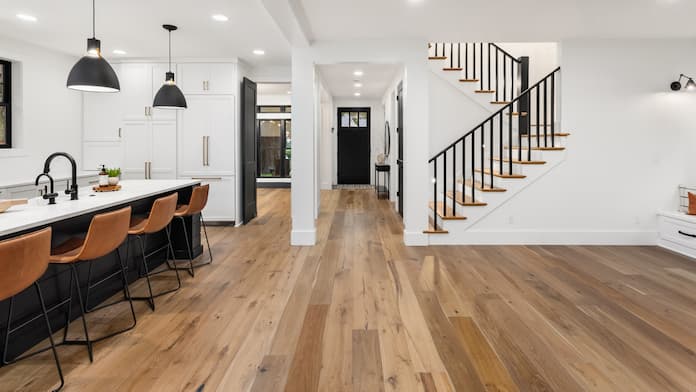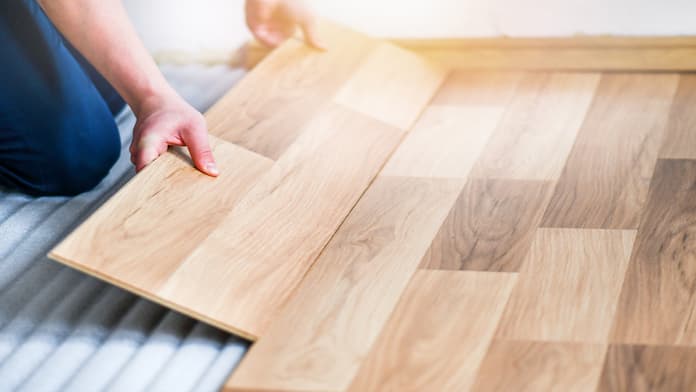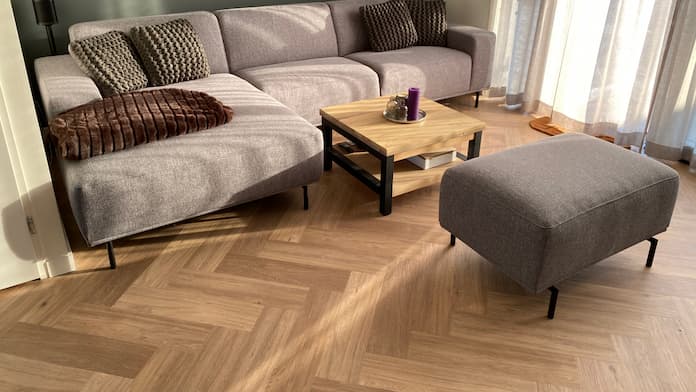How Much Does Flooring Installation Cost?
Thinking about refreshing your home with new flooring but dreading the potential costs? Many homeowners face this challenge, unsure of what to expect when it comes to installation expenses.
The average flooring installation cost for a 500-square-foot space can range from $1,500 to $4,500. The final price depends on factors like the type of flooring, labor costs, subfloor condition, and square footage.
In this article, we will break down the costs so you can plan your budget without any surprises. Plus, we’ll share some money-saving tips!
Factors That Affect Flooring Costs

According to Statista, the revenue in the Floor Covering Market is expected to hit $6.34 billion in 2024, which is huge!
When planning a flooring project, it’s important to know the various factors that can impact costs. Here are some key ones:
Flooring Type
The cost of flooring installation is significantly influenced by the type of flooring material you choose. Here’s a breakdown of how different flooring types impact the overall cost:
- Flooring Type Cost per Square Foot
- Hardwood $7 - $23
- Tile $6 - $20
- Carpet $3.50 - $11
- Vinyl $3 - $7
- Linoleum $3 - $7
- Concrete $2 - $8
Hardwood
In 2022, hardwood flooring sales in the United States reached $4.56 billion.
If you're thinking about installing this popular flooring in your home, keep in mind that it can be a bit pricey, costing between $7 and $23 per square foot, depending on the type of hardwood you choose.
Pine is one of the most budget-friendly hardwood options, whereas Brazilian walnut and cypress are on the more expensive side.
Hardwood flooring offers a timeless, high-quality look and can last for decades with proper care. However, it is susceptible to water damage and is not recommended for moisture-prone areas.
Tile
Tile flooring comes in various materials, including ceramic, granite, glass, marble, porcelain, and natural stone.
The pricing varies between $6 and $20 per square foot. Porcelain and ceramic tiles tend to be on the pricier side, and customized options can increase the cost even more.
Tiles are durable and water-resistant, making them perfect for bathrooms and kitchens, but keep in mind that they can be labor-intensive to install.
Carpet
Carpets can range from $3.50 to $11 per square foot.
They're generally more affordable and easier to install but need more frequent maintenance and replacement.
For a more luxurious look and feel, you can expect to pay more.
Vinyl
Vinyl flooring is priced between $3 and $7 per square foot.
It's affordable and DIY-friendly, especially with click-together tiles and planks. Vinyl is popular for its durability, water resistance, and easy maintenance. Additionally, it's available in a wide range of colors and patterns.
However, remember that vinyl flooring may need to be replaced or repaired sooner than other materials.
Linoleum
You can expect to spend between $3 and $7 per square foot for linoleum flooring.
It's eco-friendly and made from natural materials like linseed oil and cork dust. Linoleum is durable, hypoallergenic, easy to clean, and available in a variety of colors and patterns.
However, it does require professional installation and periodic resealing.
Concrete
Concrete flooring is a durable, economical, and sustainable option. It offers design versatility with options for staining, polishing, and texturizing.
Concrete floors are easy to maintain, pet-friendly, and can improve indoor air quality.
You can expect to pay around $2 to $8 per square foot for concrete flooring.
Labor
Labor costs for flooring installation can range from $0.60 to $4 per square foot, depending on various factors.
These factors include the size of the area, the type of flooring being installed, and the job’s complexity.
For example, hardwood and tile installations typically require more labor and are pricier than carpet or laminate installations.
Larger spaces or multiple rooms will naturally cost more than smaller areas.
Additionally, jobs with complex layouts, tight corners, or multiple levels will have higher labor costs due to the increased difficulty and time needed.
Square Footage
The larger the area, the higher the flooring installation cost per square foot due to the increased material and labor costs.
For example, installing flooring in a 2000-square-foot room will be more expensive than in a 500-square-foot room.
The Function of the Area

The function of an area influences flooring installation costs due to the need for durability, water resistance, and aesthetics.
For example, bathrooms and kitchens need waterproof materials like ceramic tiles, which can be pricier to install.
Living rooms and bedrooms usually use hardwood or carpet, which require less moisture protection, making installation simpler and potentially cheaper.
Basements often need water-resistant options like vinyl or epoxy.
Stairs and complex layouts incur higher labor costs due to the extra cutting and fitting required.
This way, you can choose the right kind of flooring for each room and save on costs.
Removal of Existing Flooring
Some homeowners install new flooring over the old one, but it’s usually better to remove the existing flooring first. This helps identify any hidden problems with the subfloor.
Also, installing new flooring on top of old flooring can increase the floor height, making it difficult to open or close doors.
If you’re considering a full flooring renovation, you might be wondering how much it costs to replace flooring.
The cost of removing existing flooring varies based on the type of flooring, but it typically ranges from $1 to $6 per square foot.
Additionally, the overall cost to redo floors will depend on the materials chosen for the new floor and any necessary repairs to the subfloor.
Underlayment
Underlayment or padding provides a smooth, stable base, enhances moisture protection, and improves sound insulation.
When budgeting for your new floor price, it’s important to include the cost of underlayment as well.
The type of underlayment chosen affects the overall cost, which ranges from $3.40 to $5.30 per square foot.
DIY vs. Hiring a Professional Flooring Installer
Some homeowners may decide to go the DIY route to save on labor costs, which typically range from $0.60 to $4 per square foot.

DIY installation gives you full control over the project, including the timeline and specific details.
However, DIY installations can be very time-consuming and often take much longer than professional installations due to inexperience and the learning curve of using specialized tools.
Mistakes in measurement, material preparation, or installation can lead to costly fixes and potentially shorten the lifespan of your flooring.
Many flooring warranties require professional installation to remain valid, so DIY installations may void these warranties, which can be a significant downside.
While DIYing flooring installation may save costs upfront, you might have to pay for costly mistakes down the road.
Professional installation ensures the job is done faster and with higher quality, thanks to their skills and experience.
Using a professional service often includes warranty protection for the installation, and providing a safety net for any issues that might arise later, which is not the case with a DIY job.
What Are the Costs of Installing Floors Yourself vs. Hiring a Professional?
If you choose to install the floors yourself, you can expect to spend between $0.50 and $15 per square foot on materials, excluding the cost of preparation and labor.
Doing it yourself can save you money on labor since you’ll handle everything from prep work and installation to cleanup.
However, even though you’ll save money, consider if you have the skills and experience to do the job right. Think about whether the potential stress, hassle, and future costs are worth it.
That’s why we recommend hiring a professional who can do the job right the first time, saving you from stress, hassle, and potential repair costs later on.
You can use a tool like HomeBuddy to find a local expert by answering a few questions. This tool helps you get a free quote from a local contractor!
When hiring a professional, make sure to get estimates from different companies, check their online reviews, and ask any questions to clear up any doubts or concerns you may have.
What are the Benefits of New Flooring?

- Increased Home Value New flooring can significantly boost the value of your home, making it more appealing to potential buyers. This is especially beneficial if you plan to sell your home soon, as updated flooring can be a deciding factor for buyers.
- Enhanced Aesthetics Whether you prefer the classic elegance of hardwood, the modern appeal of laminate, or the versatility of vinyl, new floors can update your home’s style and make it more visually appealing.
- Improved Energy Efficiency Certain types of flooring, such as carpets, can help insulate your home better, reducing heating costs in the winter. On the other hand, materials like tile and stone can keep your home cooler in the summer, potentially lowering air conditioning costs.
- Better Health and Safety Modern flooring materials are less likely to trap dust and allergens, contributing to better indoor air quality. Furthermore, new flooring options can offer improved slip resistance, reducing the risk of falls.
How Can You Save Money on Flooring Installation Costs?
To save money on flooring installation costs, you can implement these tips:
- DIY Installation If you have the skills, you can install the easier-to-install options like laminate or floating floors yourself and save on labor costs.
- Choose Affordable Materials Opt for less expensive flooring materials such as laminate or vinyl instead of hardwood, which often look similar to more expensive options and are easier to install.
- Buy Materials Online Purchasing flooring materials online can sometimes be cheaper than buying from local stores. Be cautious and compare prices, including shipping costs, and read reviews to ensure quality.
- Shop Around for Quotes Get multiple quotes from different contractors to find the best price for installation.
- DIY Some Tasks Save money by doing tasks like moving furniture and removing and disposing of old flooring yourself.
- Look for Deals Make sure you are actively looking for seasonal discounts.
- Buy in Bulk If you’re covering a large area, buying flooring in bulk can reduce the per-unit cost. Moreover, some retailers provide discounts when you buy in bulk.
- Consider Simple Patterns Complex patterns or designs can increase installation time and costs. Opting for a simple layout can help save money.
- Negotiate with the Installer Don’t be afraid to negotiate with flooring installers. Some may be willing to offer a discount or work within your budget if you ask.
When Do You Need a New Floor?
- Visible Damage If you see significant wear and tear, such as cracks, deep scratches, or stains that can’t be cleaned or repaired, it’s a sign the floor may need replacing.
- Uneven Surfaces Floors that are uneven or have large gaps can be both a safety hazard and a sign that the subfloor or floor covering is failing.
- Water Damage Persistent water damage or leaks can cause warping, swelling, or mold growth, which means the flooring might need to be replaced.
- Old Age Over time, floors can become outdated or less effective. If your flooring is several decades old, it might be time for an upgrade.
- Increased Maintenance If you find yourself spending a lot of time and money on repairs or maintenance, it might be more cost-effective to replace the flooring.
- Health Concerns If the flooring is contributing to health problems like allergies or respiratory issues, especially if it's harboring mold or allergens, it might be time to replace it.
- Aesthetic Changes If you’re remodeling or updating your space and want a fresh look, new flooring can significantly impact the overall appearance of your home.
- Safety Concerns If the floor is causing trips, falls, or other safety hazards, it's crucial to replace it to prevent accidents.
Conclusion
The average cost to install flooring in a 500-square-foot space can range from $1,500 to $4,500. The actual cost depends on the type of flooring, square footage, subfloor condition, and labor costs.
While DIY can save money, we recommend hiring a professional to ensure peace of mind and avoid costly repairs later. You can use a tool like HomeBuddy to quickly find the right local contractor for flooring installation.
Frequently Asked Questions
- What are some of the latest trends in flooring you should consider?
- The latest flooring trends for 2024 are all about natural and light wood, wide plank hardwood, and checkerboard tiles. Terrazzo and sustainable materials are in high demand too. You can also go with patterned flooring that mixes different styles and rustic textures for a unique look.
- How much does a new floor add to the value of your home?
- Installing new flooring can significantly increase your home’s value. Hardwood floors, for example, can boost your home’s value by up to 2.5% with an ROI of 70% to 80%. Other options like ceramic tile can offer similar returns.
- What is the cheapest type of flooring?
- The cheapest type of flooring is sheet vinyl, which costs between $0.50 and $4.50 per square foot. It’s durable, comfortable, waterproof, and easy to maintain, making it an affordable and practical option for different rooms in your home.

